
70 minute read
74 THE GATED FAMILY
IT’S A NEW WORLD OF “NOUVEAU FEUDALISM” FOR THE ELITES (AND THEIR STAFF) SEQUESTERING FROM MODERN THREATS. BRANDON PRESSER REPORTS FROM
INSIDE THE BUBBLE
Advertisement
ILLUSTRATIONS BY JOEY YU
Gated The Family

“C owboysand Indians,” Madeleine Pickens responds with a girlish inflection, as though she’s ready to bring down a trunk of Stetson hats and feathered headdresses from her attic. It’s why she moved to the United States 50 years ago: “I’ve always dreamed of life on the frontier.” Born in the Middle East to British expat parents and raised in boarding schools in the UK, Pickens’s pioneering spirit had her serving moist towelettes and cigarettes on Pan Am flights before starting her own business sta ng private jets with elite crews. Today, she lives in Southern California (Bill and Melinda Gates bought her former oceanfront home for $43 million earlier this year) and counts both aviation magnate Allen Paulson and hedge fund tycoon T. Boone Pickens as ex-husbands.
Like Pickens, countless legions of Europeans have, over the centuries, heeded the call of the Wild West to manifest their destiny—a byword for what would later be rebranded as the American Dream. But along with their gold-digging trowels, these adventurists also carried with them the very European propensity to separate the haves from the have-nots. The dukes and earls of the old world found their equivalents in the magnates and tycoons of a modern nation where money—not family—formed its aristocracy.
Social stratification is as old as the Pyramids, of course. But it was perhaps starkest during the Middle Ages, when lords and ladies of the manor ruled over serfs who worked their land until the Black Death swept through Europe, breaking the yoke of cloistered servitude. Ironically, it’s another pandemic that’s reviving this way of life once again. In today’s nouveau feudalism, elites are gathering their sta and themselves safely behind the high walls of their fourth homes to keep themselves removed from modern threats.
Pickens would know—she owns Del Mar Country Club, a grassy enclave that sprawls across one of America’s most a uent zip codes, close to San Diego. For the first time since the Great Recession, membership is noticeably up. Pickens used to be wistful when she’d reminisce about life at the club before 2008—the same twinges of longing when she imagines her frontier fantasies: the over-the-top galas, lavish weddings, and other such showboating of limitless wealth. But now, despite the Covid-related closure of the clubhouse, card carriers are once again lined up at the gates, clamoring to get in for brunch on the patio.
JULIE DANZIGER, EMBARK BEYOND MANAGING PARTNER
Further up the coast in Los Angeles, famed hotelier André Balazs announced this summer that he would turn Chateau Marmont into a completely private venue, with an eye on expanding into international markets like London, Paris, and Tokyo in the near future. Sure, VIP lists have kept the plebs outside of its velvet rope for years, but Covid has been the propellant to formalize the members-only experience as clientele now require safety just as much as they do privacy. The property’s top 100 guests generate the majority of its profits, so by knowing outright who the most valued patrons are, sta can more swiftly ensure their care.
A private club may solve the recent quandary of where businessmen can execute their midday meals-and-deals. But what about the location dilemma for today’s “ladies who lunch”—now “ladies who crunch”… their abdominals?
“I would say it was some time in the last two years that I started getting invited to Pilates classes rather than cocktail parties,” says Jean Godfrey-June, beauty director at Goop, Gwyneth Paltrow’s lifestyle brand. Green juices and SoulCycle sweat sessions have replaced dirty martinis and lobster Cobbs. “Wellness is the perfect outlet for those who have plenty of time and ample money,” Godfrey-June notes, but unlike the hospitality business (where well-heeled diners can hopscotch between cordoned-o venues), fitness studios remain virus hot zones, which has forced the industry into the homes of its constituents— all of whom have been busily turning their extra bedrooms into spas and gyms with the same zeal as executives setting up home o ces.
Since the pandemic started, Peloton’s sales jumped 66 percent in its third fiscal quarter, Lululemon’s online business leaped 70 percent in the

early summer, and Goop can’t keep its products stocked on their virtual shelves—infrared sauna blankets ($500) and gemstone heat therapy mats ($1,050) are selling out faster than a Taylor Swift concert once did.
“And our beauty products, too,” Godfrey-June adds. “Women can’t get their usual facials or treatments, so they’re finding do-it-yourself substitutes instead.” She recommends the Jillian Dempsey Gold Sculpting Bar (practically free at $195), which helps keep the face firm when your dermatologist’s arsenal of injectables aren’t at your disposal.
While the lion’s share of high-net-worth individuals are working and welling from home (yes, it’s a verb now), there’s a subset of society that’s found a more unconventional way to pull life’s trappings into their quarantine bubble: five-star hotels.
“There are challenges with stand-alone villas and summer homes that hotels can easily solve,” explains Julie Danziger, a managing partner of EMBARK Beyond, a luxury travel planning service based in New York City. After sending her clients on lavish summer getaways, they all

Raise the Drawbridge
Resources for avoiding the pandemic in style
MADELEINE PICKENS, DEL MAR COUNTRY CLUB OWNER
DINING
Like Balazs and his collection of hallowed hangouts, legendary London members-only club Annabel’s is also primed to take over the world, making landfall on US soil at the end of the year with the opening of Oswald’s—named for owner Robin Birley’s grandfather—on New York’s Upper East Side.
TRAVEL
Exclusive Resorts is a club without a clubhouse: a private travel service that o ers its 4,000 member families access to the largest privately owned portfolio of villas in the world, with more than 400 vacation homes worldwide. Despite travel restrictions and economic decline, the service saw a 540 percent increase in sales this April. After the $100,000 initiation fee for a ten-year membership, each holiday night costs $1,395 for any property in the collection.
came back in the fall wanting more. “Having everything—a restaurant, fitness center, movie theater, medical care, and round-the-clock cleaning—at your fingertips is gold,” Danziger says, “and resorts are adhering to the strictest sanitary guidelines in an attempt to garner guests.” Transforming full-service properties into souped-up gated communities has become such a fruitful endeavor for Danziger that’s she developed a special department—EMBARK Longer—to vet the surplus of long-stay requests. Dozens of hotels around the US and Caribbean are reporting three- to six-month stays, and most of the 63 rooms upstairs at the Chateau Marmont have been taken over by full-time guests who feel much safer on property than they do down the street in their own, fully sta ed homes.
Whether sequestered at their weekend retreat, or hidden away at the Chateau, the haut monde has quickly adapted to the gated life by throwing gobs of money at each problem as they arise— dining, wellness, health, travel, and even education. There’s just one conundrum that has yet to be adequately resolved: how do you put the “social” back in “socialite” when we’re all relegated to Zoom?
Pickens believes she’s found the answer. “It’s all about golf. You’re outside in your pod of four or six and you can talk distantly as you walk between each hole.” Interest in the sport may have been flagging before the pandemic, but Pickens ardently asserts that Covid has minted a new generation of enthusiasts who are now out on the greens and fairways, putting with their fathers—“it’s almost impossible to get a tee-o time at Del Mar,” she adds.
“The summer has really been a boon to our community,” agrees Godfrey-June. “We’ve just taken our network outside.”
Now, with the colder months upon us—as we coop ourselves back up in our gilded cages— Pickens is ready with another solution: the keys to Mustang Monument, her very own fiefdom in the high desert of northeast Nevada measuring 900 square miles, almost the size of Rhode Island. She purchased the land in 2010 in a bid to help save a thousand wild horses from slaughter, then conceived of an eco-lodge to help defray its maintenance costs. As Covid continues on, Pickens is leasing out her property wholesale to interested renters: you know, in case you want to live your dreams of frontier life too.
TRANSPORTATION
The CARES Act suspended the federal excise tax on domestic flights, both commercial and private, chopping 7.5 percent o rates; low fuel costs and the need to keep pilots of grounded business planes licensed are also contributing factors to noticeable the dip in pricing. Call luxury planner Meredith Broder to skip the major airports and commute—or travel— around the country using crowd-free FBOs (fixed-base operators).
WELLNESS
Build your own spa with Goop’s curated items, like a Theragun, which approximates a masseuse’s hands as it unclenches muscles. Then, upgrade your home gym with Peloton’s new, top-of-the-line Bike+ or get a Mirror— recently acquired by Lululemon for $500 million—which streams live Pilates, barre, and yoga classes, if you’ve grown tired of FaceTiming with your personal trainer.
MEDICINE
Concierge health services like Forward or One Medical o er unlimited access to privatized care and may put you at the front of the line when a Covid-19 vaccine is released. Or, for $30,000 a year per adult, join the invite-only Private Medical, which, sources tell us, caters to only 800 families with its elite care.
LIVING
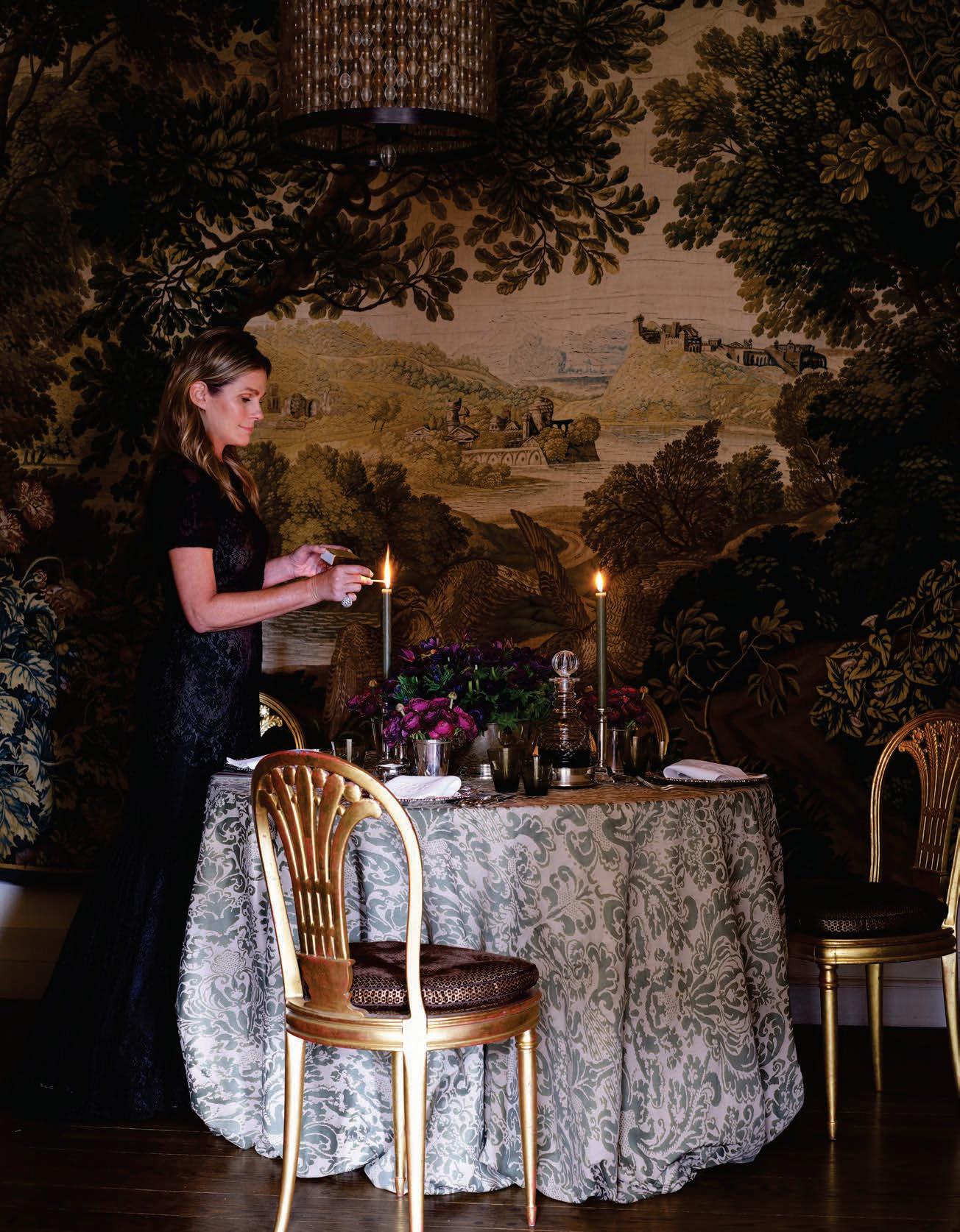
Miss En Scène
CANDLELIT WINNER Aerin Lauder lights candles for a small dinner for four in the foyer of her New York apartment, on the walls of which hang an 18th-century Beauvais tapestry. “Soon after we moved in, I found this tapestry and decided it would make a dramatic yet warm backdrop for the space,” she says in Entertaining Beautifully. “Perhaps it reminded me of my grandmother’s opulent New York City townhouse.”
AERIN LAUDER’S NEW BOOK, ENTERTAINING BEAUTIFULLY, SHOWCASES THE HOME DESIGNER’S CAPTIVATING STYLE. ON A VISIT TO THE GORGEOUS ESTATE SHE INHERITED FROM HER GRANDMOTHER, WENDY MOONAN SWOONS JUST A LITTLE
The Lauder family is known to be closely knit, at work, at play, and at home. In fact, asked about lockdown during COVID-19, Aerin Lauder Zinterhofer says she continues to work remotely, and although she misses being able to travel, she is philosophical. “With the bad, you get the good,” she says, speaking one recent morning at the family home on the East End of Long Island she shares with her husband, Eric Zinterhofer, an investment banker, and their sons Will and Jack, 20 and soon to be 21, respectively. “It was special to be home with my two boys so much before they went o to college; dropping them o at the Wharton business school in late August was bittersweet. And I got to spend a lot of time with my father”—Ronald Lauder, chairman emeritus of the Estée Lauder Companies and president of the World Jewish Congress—“who is normally traveling all the time.”
FIRESIDE CHATS The library in Aerin Lauder’s Upper East Side home is the preferred spot for the Christmas tree and a place where she likes to entertain throughout the holiday season.
As we learn in Aerin’s new lifestyle book, Entertaining Beautifully, in which she shares her personal thoughts about hosting and which encompasses more than twenty celebrations, the Lauder family famously celebrates holidays together, including the Fourth of July, Thanksgiving, Hanukkah, and Christmas. In a normal year, she says, “We have Thanksgiving dinner at my parents’ house in the Hamptons, usually 60 or 70 people, including my sister Jane, the parentsin-law, and all the children.”
This year? Probably not.
“I think that it’s very important to still celebrate the holidays, even during this unique time,” she says. “The holiday season has always been filled with family, nostalgia, and wonderful memories, which will not change this year. I plan to decorate my home and spend quality time with the people who are most special to me. I’m looking forward to my favorite classic comfort foods and entertaining at home in a new way.
“Entertaining doesn’t always have to be a large, formal gathering,” she adds. “Hosting a smaller group in an intimate setting can be just as meaningful.”
We are seated in the pool house of the Greek Revival, Tara-style Hamptons mansion not far from Georgica Pond she inherited from her grandmother, Estée Lauder. Beautifully dressed in a chi on print blouse, wearing gold jewelry and gold sandals from her own line, Aerin, 50, is poised, unpretentious, and candid. “Living in her house has been so comforting during lockdown,” she tells me. “Using her plates and silverware, I feel her presence.”
The design of the pool house was adapted from a Slim Aarons photo of Babe Paley leaning on a pillar of her pool house in Jamaica. “That simple, elegant structure, open on two sides, was the inspiration.” Apart from a few

floral throw pillows, everything is white: walls, floor, ceiling, co ee table, garden seats, the canvas upholstery on the rattan seating, even the coral chandelier. The decor is pristine and calming. (“I hate clutter,” she confesses.)
On the coffee table she has proudly arranged some of her products: faux-shagreen boxes, fragrance candles, flower vases, and an elegant woven ra a tray from a line that she has fabricated in Italy. They are, like her, traditional, chic, and well-mannered, not trendy nor cutting edge. These are pieces that won’t go out of style.
This year, despite the pandemic, Aerin plans to participate in another beloved Hamptons family ritual she details in Entertaining Beautifully: a casual lunch the day after Thanksgiving with her mother, Jo Carole Lauder, and father. Her mother hosts the lunch in a rustic, centuries-old log cabin that was moved to their property from Virginia. “It is furnished with primitive Austrian wood furniture and filled with charm and history that transports us back to another era,” Aerin says. Her father served as U.S. ambassador to Austria in the late 1980s, when she was a junior in high school, and she has fond memories of Vienna.
The atmosphere of the cozy cabin interior is gemütlich (for those without a Berlitz handy: “pleasant and cheerful”). A small antique Austrian trestle table is surrounded by simple Tyrolean country chairs with heart cutouts in their backs. The table is set with folkloric dishes, monogrammed redand-white gingham napkins, horn-handled flatware, and pots of red geraniums. “My mother has long collected a type of hand-painted earthenware pottery made in Austria,” she explains. “These ceramics have been made in the town of Gmunden, on the shores of Lake Traunsee, since the 1400s. The whimsical, green-and-white-striped and looped dizzy patterns, as well as the leaping green deer, are my favorites.
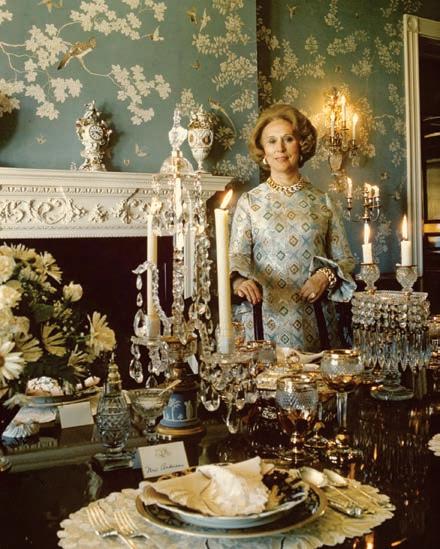
ALWAYS BEEN FILLED WITH FAMILY, NOSTALGIA, AND

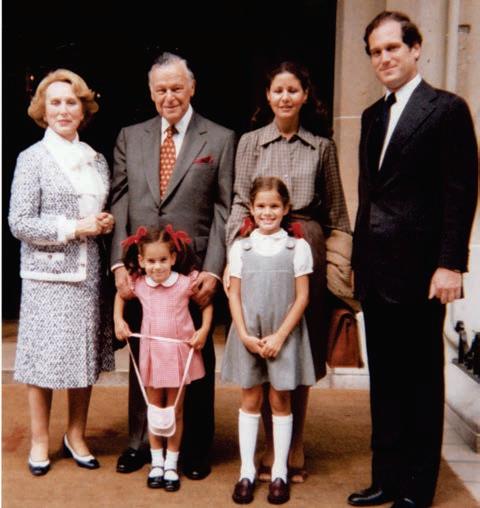
AERIN LAUDER

FAMILY MATTERS Clockwise, from above: the Lauder family gathered at Estée Lauder’s home in Palm Beach in 1972; Estée at her formally set table in Palm Beach, where she spent her winters; Aerin on a ski holiday with her two sons; a young Aerin with her sister, Jane, and their parents, Jo Carole and Ronald Lauder, and grandparents Estée and Joseph Lauder, at the Hôtel Plaza Athénée in Paris; Aerin and her husband, Eric Zinterhofer, following their marriage ceremony in 1996.


AERIN LAUDER
CABIN FEVER The centuries-old log cabin Aerin’s parents had moved from CABIN FEVER The centuries-old log cabin Aerin’s parents had moved from Virginia to their property in the Hamptons is the setting for a beloved Lauder family ritual, a casual lunch the day after Thanksgiving. The antique sled table and Tyrolean chairs from Austria add to the rustic air. Opposite: Aerin at home on the Upper East Side.


“After the elaborate Thanksgiving feast, this simple, bucolic meal with turkey leftovers is an ideal antidote,” she continues. “It can be just as creative—if not more so—to entertain in a rustic, bare-bones space as an elegant, luxurious one.”
Growing up with such stylish parents, is it any wonder that this Upper East Side entrepreneur has become the face of her own lifestyle brand, along with her own makeup and fragrance lines? After working for 25 years (since interning at college) at the Estée Lauder company, where she still retains the title of style and image director, in 2012 she launched AERIN, her own beauty, home, and luxury lifestyle label, where she serves as creative director. “The whole brand is about surprise and delight,” she says.
Her elegant boutiques in East Hampton, Southampton, and Palm Beach showcase her creations as well as those of friends, including a line of dresses by Amanda Ross, a former Harper’s Bazaar editor. “Fashion has always been part of my life,” says Aerin, who was regularly featured in the glossies, pre-COVID, at parties wearing Oscar de la Renta, Derek Lam, Stella McCartney, and Michael Kors. “When I was 15, Estée took me to Paris to see the fashion shows. I was riveted.”
Inspired by her grandmother, Aerin is a hard worker, like her fellow Park Avenue women entrepreneurs Tory Burch, Cristina Cuomo, and Lauren Santo Domingo. “We are all in di erent businesses, but I love strong women.” Asked about her schedule, she says, “I am defi nitely an early riser; I don’t sleep very much. The fi rst thing I do when I wake up is take the dogs out. If I’m working out, I prefer to do that in the morning as well, before I start my day. I love Pilates and going for walks outdoors. I like to go alone; I get my best work ideas when walking.” On weekday mornings she can be found walking her dogs in Central Park, not far from the family home on the Upper East Side.
Her work day? “After having a cup of co ee and getting dressed, I spend my day on calls or in di erent meetings. No two days are ever the same, which is one of the reasons why I love what I do. I am very hands-on.
“Sometimes after work I meet up with friends like Lauren duPont and Samantha Boardman, since I fi nd old friends are the people you depend on,” she continues. “Then, after a busy day, my favorite thing is to have dinner with my family. It helps me unwind, disconnect from work, and reconnect with the people I love most.” She proudly points out that Estée went to work every day until she was in her mid-eighties. It is easy to imagine Aerin Lauder doing the same. She shares a favorite saying of her grandmother’s with me: “There is no such thing as an ugly bride, only a lazy one.” In other words, if you try, you can be beautiful and have a beautiful life. She will show you how. Entertaining Beautifully is published by Rizzoli.
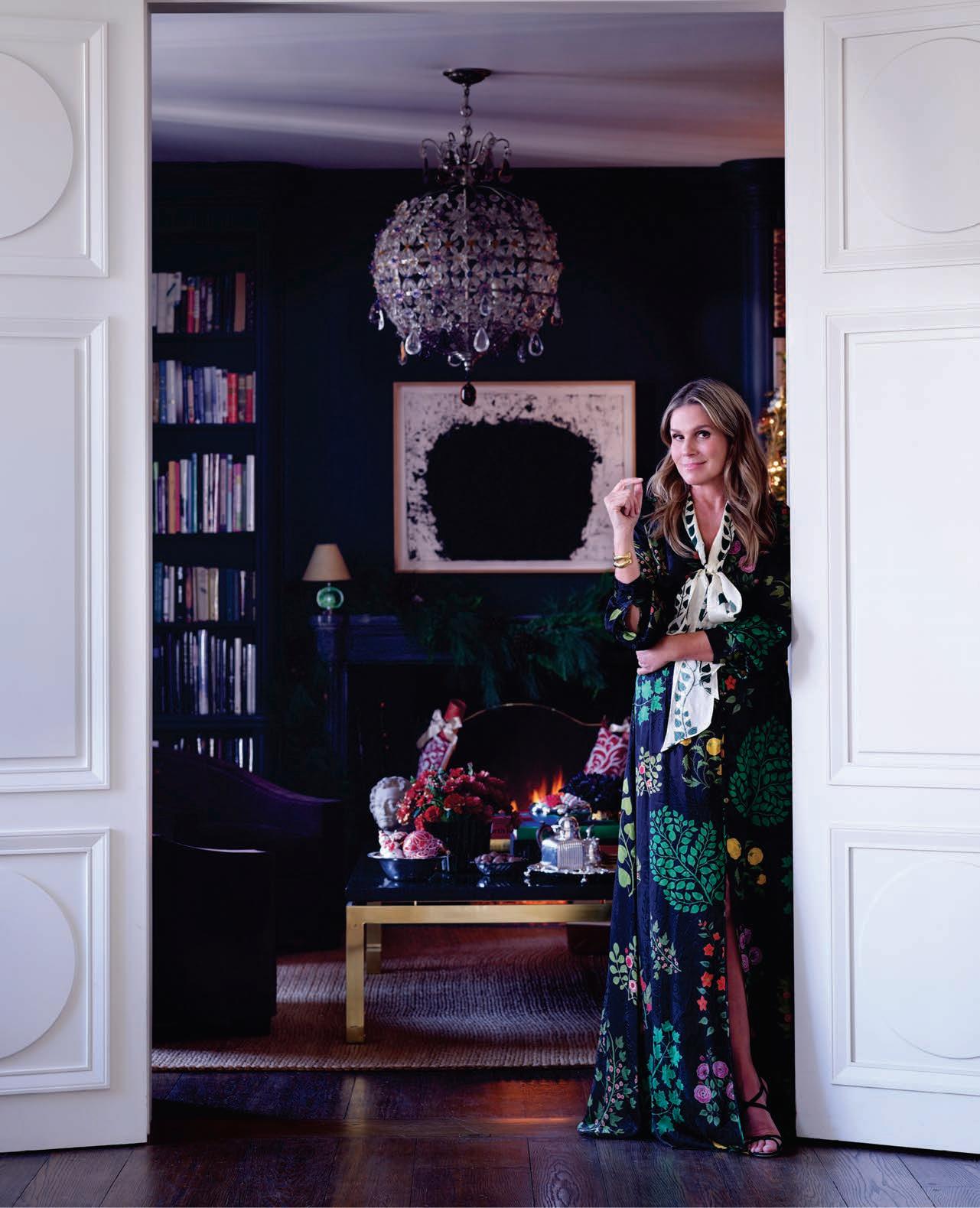
The ART of the FEAST
THERE’S NO BETTER TIME TO ENJOY AMERICA’S RICH VARIETY OF CULINARY TRADITIONS THAN DURING THE HOLIDAYS. ABBYE CHURCHILL DIGS IN

46 MILLION TURKEYS WILL BE EATEN IN
THIS COUNTRY FOR THANKSGIVING ALONE.
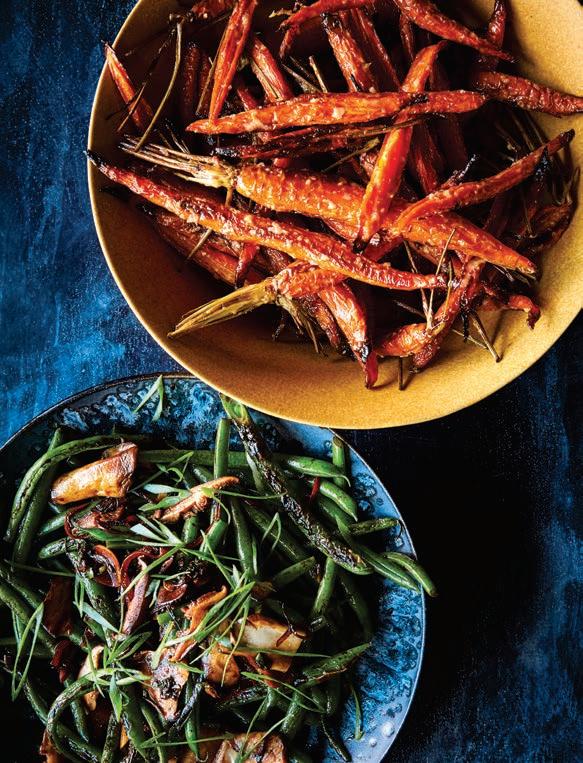
Sure, the holidays are when we come together with loved ones. Yes, they are the times when we practice gratitude for all that we have. And, true, there’s gilding the home, reuniting with family, and all that, too. But, above all else, the holiday season means one thing: a feast.
Growing up, our holiday meals were defined by the glorious, glowing bird. Roasted to golden perfection, glistening and lacquered from hours slow roasting and basting in the oven, and served alongside its juices simmered and thickened into a hearty gravy, the holiday bird has always been the focal point of the holiday meal.
Achieving that perfect, glistening brown takes some doing—and seasoned cooks will have a

wide variety of opinions on just how to achieve it. Some chefs pledge that leaving the bird out on the counter for hours to warm to room temperature before roasting allows the bones to better hold heat and roast from the inside out. Other cooks are devoted to letting their bird soak for a full day in closely guarded family recipes for brine to make the meat luscious, juicy, and fall-o -the-bone tender. Others swear by massaging the bird with salt and cream the night before. Yet dissenters insist that it is only ever about the basting—the constant, loving application of butter, butter, and more butter while the meat slowly cooks to absorb all that liquid gold and those aromatic herbs until it has reached holiday nirvana.
In our home, preparing the Thanksgiving turkey or New Year’s roast always begins early in the morning, alongside the last scrapes of dishes from the breakfast crowd of those fortunate enough to have slept in. We prepare a compound butter with sage, rosemary, and sea salt and slather it liberally across the bird. Some brave turkey masters insist on lathering their bird between its skin and meat, being careful not to wholly sever the connective tissues while they do—but we’ve always been a more modest over-the-skin-only household. After this buttery coating is applied, we rest it on top of a bed of mirepoix, liberally flood the pan with a bottle of good white wine and some stock, and pop it into the oven with our best wishes for a perfect outcome, while enlisting a rotating team of family members with basting duties.
The holiday meal centerpiece—like the American table on which it is served—can contain multitudes. The seldom eaten parts of the turkey, secretly thought to be too gross for polite company, are often old-world delicacies. At holiday feasts all throughout my childhood, the neck of the turkey was the first item from the cooked bird to emerge from the kitchen. It was served for one man—my grandfather, the venerated patriarch of the family, whose tastes required this special preparation exclusively for him. At other households, it might be the gizzards, which I’m told (by braver feasters
STUFFINGS, GRAVIES, SALSAS, SAUCES,
than I) are decadent and delicious when prepared as confit. Part of the joy of the family feast is to watch these divergent pathways of intergenerational tastes simultaneously at work. Elders and immigrants who, when they were children, were fed tripe, liver, or, in coastal northern locales, pungent fish like anchovies or fried smelts can find their prestige treats served up special, owing to the kindness of the holiday season, as well as their progeny.
If it isn’t a holiday without a bird at your table, you’re not alone. In the American household around the holidays, odds are the centerpiece is roasted fowl: 46 million turkeys will be eaten in this country for Thanksgiving alone. But our country is vast and diverse, and so are our traditions. More likely than not, if it isn’t turkey, then it’s ham. In the South, you’ll find it glazed with mustard and brown sugar, garnished with cherries or pineapple, perhaps even studded with cloves. Americans in the South and across the nation make it a tradition to serve candied yams and black-eyed peas over the holidays; the legume is thought to represent good luck, and can be served along with pork and spicy jambalaya, or prepared with creamy rice gravy and greens as hoppin’ John.
For many Americans, the holiday spread would not be complete without tamales as a key component of the feast, with beef, pork, or chicken surrounded by a layer of tender cornmeal and steamed in a corn husk, along with buñuelos, traditional Mexican fried yeast doughnuts laced with cinnamon and sugar, and sometimes flavored with sweet anise. For others, the sight of piping hot latkes being cooled by a dollop of sour cream conveys the holiday table, while in many other households the holiday centerpiece might be a crown roast of lamb, fragrant with nutmeg, cardamom, allspice, garlic, and rosemary, served over savory rice with pine nuts.

At a Greek-American family table, you might find stuffed grape leaves, deep green pillows stuffed with rice, herbs, or sometimes minced meat, topped with a traditional delicious egg-lemon avgolemono sauce. Or, for many households harboring connections (culinary or otherwise) to the British Isles, the feast’s focal point might be a beef Wellington, that classic savory and luxurious dish combining tender fillet of beef with goose liver pâté or a rich duxelles of mushrooms, all of it engulfed in flaky pastry. The holiday feast is not only an occasion to serve up the most delectable dishes, but also the ones that showcase the culinary traditions from among a panoply of American cultural heritages.
Arguably, however, what makes the feast worthy of its name is the eclectic array of side dishes that fill the table with color and provide a harmonious assortment of flavors. Think of the way roast vegetables showcase transformative texture—how the humble and stonelike potato is elevated to the airy, velvety creaminess of a holiday mash. Or how the green leek, crunchy and verdant, becomes translucently layered on a savory leek tart, or lends invisible onion aromatics to a winter leek soup. Consider, too, how Brussels sprouts spring upward from their cabbagey peasant lineage and become tender pockets of earthiness when they’re halved, seared, and roasted with sage and pancetta.
My favorite side dish, however, has always been potatoes Anna, which are really thinly sliced potatoes layered in a cast-iron skillet, brushed generously with a coating of butter atop each layer, crisped to golden brown, then baked. The result is a soft, biscuit-like dish you cut like a pie—a singular slice of heaven.
Stu ngs, gravies, salsas, sauces, and cranberry compotes inspire a diversity of recipes as various as the personalities who cook them. In the running narrative of a family’s holiday traditions, these accoutrements can inspire not just philosophies, but entire family feuds: Does the ideal gravy incorporate flour, for a thicker and richer
FOR DAYS AFTER THE BIG MEAL.

topping? Does a savory sage and sausage stu ng made with challah bread threaten to upstage the meat it stu s? If a cranberry sauce features intact cranberries along with clove-laced chunks of orange and apple, is that more of a cranberry relish? Questions—and strongly held opinions—abound. However, such matters of opinion and dispute are in fact literally baked into our American traditions. Pies, not cakes, frequent the holiday dessert table—a tradition started when early American colonists outlawed the celebration of Christmas. Instead, they imported the English tradition of savory pie making into the harvest festival, incorporating North American vegetables like squash, sweet potatoes, and the now ubiquitous pumpkin. While the generous dollop of lightly sweetened whipped cream is certainly a more modern advancement, the pumpkin or sweet potato pie dessert tradition is as American as, well, apple pie. The magic of the holiday feast is in the past coming to greet us in the present. Preparing the holiday meal gives us a chance to connect with our traditions and to follow our family recipes. For as contentious or kept-secret as they may be, they are ours. We will carry them with us year over year, from one generation to the next, until questions like Is it a relish? or Do we brine our turkeys? or Is applesauce or sour cream a better latke partner? are no longer up for debate, but simply part of our family traditions: steadfast, delicious, and served at a table all our own.
And, as an added bonus, the holiday feast often generates enough leftovers to keep us fed and happy for days after the big meal—which can inspire its own set of traditions. Here’s one our family has recently taken up: The New Year’s Eve feast, which might feature smoked or poached salmon or a holiday roast, baked potatoes, or fresh-from-the-oven rolls, can find new life the morning after. As your hungry (and hungover) guests rouse from all corners of your home, greet them with leftovers transformed: last night’s salmon in their omelets and potatoes re-crisped into a salty breakfast hash, all served alongside a day-old roll, buttered and toasted on a griddle. It’s as fine a way as any to begin the new year, and usher in another year of new traditions yet to be discovered.
Holiday In
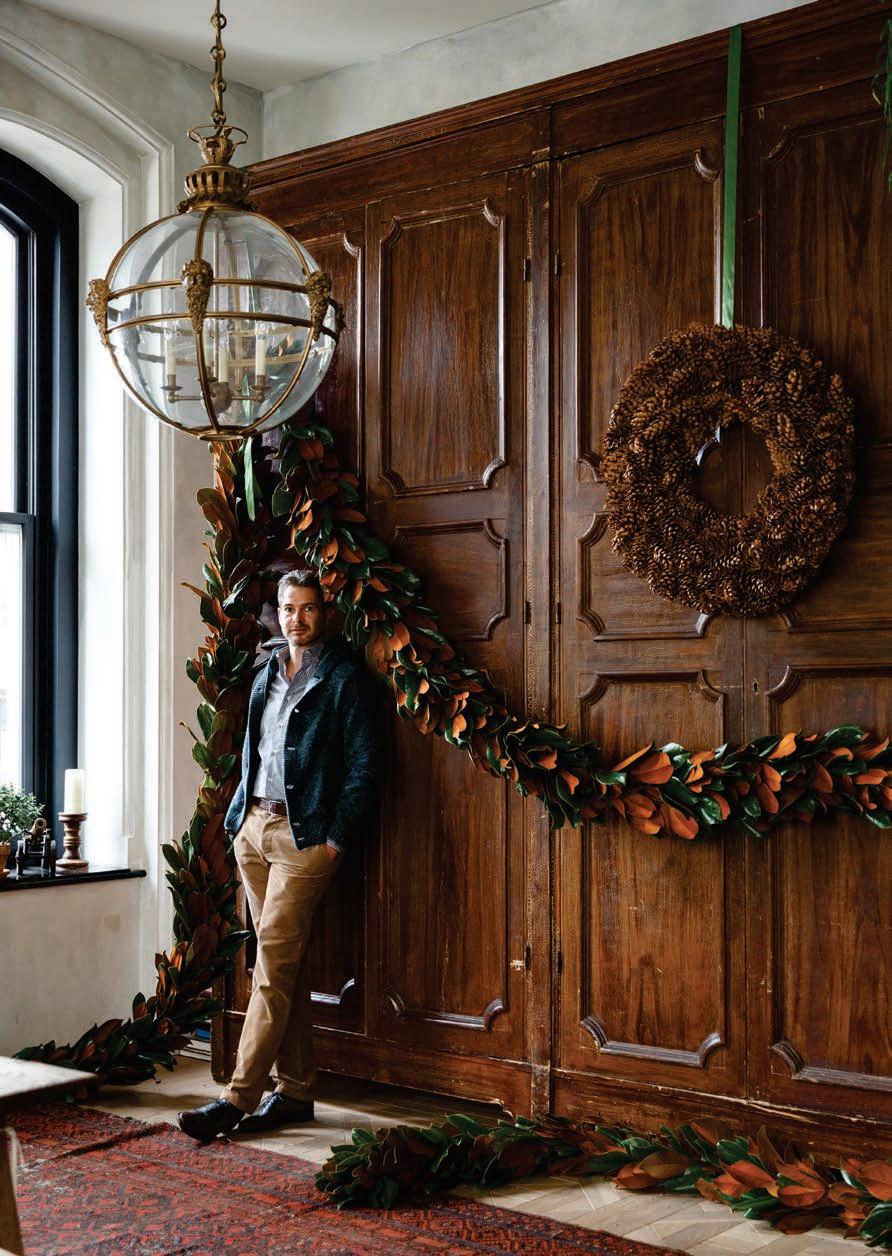
CHRISTMAS STAR Mood creator and holiday decorating maestro Bronson van Wyck.
THE BIG PARTY TREND THIS HOLIDAY SEASON? SMALL IS HUGE. MELISSA FELDMAN KNOWS EXACTLY WHO CAN HELP YOU THROW A CHIC, RESPONSIBLE GET-TOGETHER, FROM THANKSGIVING TO NEW YEAR’S EVE
The holiday months are typically a time of parties and dinners with family and friends, with homes decked, champagne and canapés flowing, and general merriment. This year “less is more” is the new mantra for entertaining, and that goes for guests as well as what’s served. While shoulder-to-shoulder tables were popular pre-pandemic, more intimate get-togethers are now the preferred model. The city’s top event planners, decorators, chefs, and caterers are adapting their work accordingly, downsizing on scale without diminishing their vision.
B Floral
Bronson van Wyck knows exactly who has been naughty and who has been nice: His eponymous firm Van Wyck & Van Wyck has masterminded multimedia environments for presidents, rappers, and socialites on the Upper East Side, among others. This year he is conjuring nostalgic themes of Christmases past for his client’s soirees. With motifs that include pine cones, yards of tartan ribbon, antlers in resin and gilded finishes, and plenty of glitter, a gay old time is guaranteed. vanwyck.net
Erin Swift, Holiday Workroom
After years toiling as a stylist and editor, Erin Swift launched Holiday Workroom two years ago, a custom decor service for sourcing and dressing the holiday tree. Her repertoire includes a compendium of seasonal trees and styles including Greenwood Essential, New England Classic, Scandinavian Modern, or Uptown Royal, o ered in various heights and species from Douglas to Frasier firs. Custom options may require a bit more elf time when a tree of their client’s dreams is being realized. Swift and her merry team can string lights, hang ornaments, arrange floral centerpieces, design bespoke wreaths, or wrap gifts, while leaving your abode as spotless as when they arrived. Professional installations can take from one to 10 hours, and masks and hand sanitizing are standard. Tree removal service is optional. holidayworkroom.com
Laura Hurst, Morning Cloak Flowers
“Using what the environment o ers and refining it into an arrangement is my favorite way to decorate for the holidays,” Laura Hurst, flower farmer and owner of Morning Cloak Flowers, says of her organic creations. Hurst’s preference for foraged species, including garlands of greenery along with bayberry, pine, dried grasses, and holly, all make for sustainably forward arrangements. Hurst adds, “I don’t usually do trees unless the client wants an unconventional one.” morningcloakflowers.com Known for its ultra-sleek aesthetic, B Floral also o ers unique bouquets for clients that broadcast the holiday season without going overboard. Their rule of thumb: Keep the overall aesthetic monochromatic and streamlined, while showcasing metallic flourishes and shades of blue. An alternative signature option includes an understated winter white floral arrangement that doesn’t clash with existing decor. bfloral.com

Mieke ten Have
Stylist Mieke ten Have has spent the past decade collaborating on interior photography for shelter publications including Architectural Digest and Elle Decor. Lately, she has channeled her passion into a new enterprise, providing holiday tablescapes for private clients who require a personal touch. With a secret stash of vintage dishes manufactured by Ti any, Wedgwood, and the late Parisian decorator Alfred Pinto, she plans to deck the halls and create custom table settings adorned with flowers, china, silver, and crystal for intimate seated dinners of ten to
Decor Directors
Bronson van Wyck, Van Wyck & Van Wyck ↑
PRETTY WILD The "Noah’s Ark" holiday tree conjured up by Bronson van Wyck features vintage taxidermy, carved wooden decorations, hand-crafted papier-mâché and blown glass globes.
twelve. mieketenhave.com

Social Studies ↑ For those who want to keep it simple, rental start-up Social Studies launched last year with the unassuming concept of a party in a box. Choose from inspired settings like Dark Nordic or White Out, equipped with all the accoutrements to set an Instagram-worthy table. Online instructions walk a newbie host through the process, from picking a theme to establishing a date, time, and guest count. Party kits get delivered to your door, in advance of the big day, with each order supplemented with recipes, tips, and playlists that add a virtual assist through the night. Customize with your own floral buds, garlands, or a sprig of green to complement your chosen style. When the party is over, repack everything and schedule a pickup. social-studies.com
Cozy Caterers
Ryan Maerz, Canard Inc.
When it comes to the guest list, “twenty is the new 200,” says Ryan Maerz of the current mood. Maerz and head chef Jose Delgado consistently create sophisticated nibbles for clients in the 10022 zip code. This season, the pair, who relaunched this luxe catering company two years ago, are orchestrating tiered bento boxes containing three to four courses to be delivered, or in-home chef-prepared menus such as a salad of brussels sprout leaves, arugula, diced butternut squash, and toasted pumpkin seeds with lemon pumpkin vinaigrette; short ribs with cauliflower puree, horseradish bread crumbs, and green asparagus; and Pavlova with winter fruit compote for dessert. Self-serve pre-batch eight-ounce cocktails and wine will also be available for individual pours. canardinc.com
Acquolina To Go
For those too busy to make plans in advance, event producer David Stark recommends Acquolina To Go Catering for a festive holiday meal. “The food quality is very, very high,” says Stark, and “the finishing directions are very clear, while the food tastes as if it was made at home. They will pick up wine on the way to deliver to you. A great entertaining solution and a brilliant gift to give,” he adds. acquolinatogo.com
Stephanie Nass, Chefanie
Chef and caterer Stephanie Nass was hosting dinner parties in her apartment at the age of 23 and has since transformed that passion into Chefanie, a catering and lifestyle brand. Sweet treats are embellished with her signature Chefanie Sheets, a vegan confection in a variety of signature designs, including tartan plaid. Custom cakes, cookies, and lollipops, as well as donuts for Chanukah, are available for delivery in and around Manhattan. chefanie.com
6 Feet by Mimi Brown
Mimi Brown has pivoted to the new intimate entertaining model, with her event production company highlighting contactless deliveries, unusual environments, and chic decor. Full disclosure: Brown, who is known for chic events

for the fashion crowd, is also moonlighting as an interior designer and is ahead of the curve, installing self-serve stations and producing monogrammed masks to match napkins and table decor. “Keep it small, keep it safe,” Brown says. mimibrownstudio.com
Meaghan Dorman ↑ For Meaghan Dorman, premade batch cocktails are the recipe for chic, easy entertaining. As bar director and consultant for downtown boîtes Raines Law Room and Dear Irving, Dorman has been creating cocktails for the past 15 years. Her Sweater Weather cider-based cocktail will keep you cozy, provided you don’t drink the entire batch. Dorman also advises hosts to keep refill ingredients prepped and accessible in advance to stay engaged with their guests. She’ll be o ering a bevy of cocktail kits, including old-fashioneds, martinis, and Aperol spritzes, as well as custom orders available for delivery to your door. meaghandorman.com
Jordana Blitz, Little Gem
After spending a decade at accessories brand Coach, four years ago Jordana Blitz created Little Gem, a fashion-focused catering and events business. Her fashion and luxury clients include a coterie of bold face brands such as Valentino, Hermès, Ti any, Burberry, and Tory Burch. Blitz is currently concentrating on private clients and is gearing up for Chanukah, with her version of a latke as a crisp parsnip pancake, served with crème fraîche and a choice of Russ and Daughters smoked salmon, caviar roe, or apple horseradish slaw. She says her one-bite s’mores tarts are the company’s most requested holiday treat. littlegemnyc.com
Elizabeth King and Paul Farrell, Kings’ Carriage House
If Kings’ Carriage House sounds like a throwback to old New York, it is. Installed in an actual former carriage house, this Upper East Side institution has created afternoon high tea for local patrons since opening in 1994. This holiday season, their traditional high tea service will be packaged to go, including their savory finger sandwiches, scones with cream and jam, and a delicious assortment of homemade cakes and holiday sweets. And tea, with all the trimmings. Champagne optional. kingscarriagehouse.com
Personable Chefs
Laura Geraty and Rian Tompkins, What We Eat
What to Eat is a small, yet mighty (in founder Laura Geraty’s words) Brooklyn-based group of all-female professionally and nutritionally trained personal chefs. Billy Cotton, the new creative director for Ralph Lauren Home, has used them as his catering go-to. This holiday season they plan to enter client kitchens to cook holiday meals in situ. Either seated or bu et, they will prepare traditional dishes from your auntie’s timeworn recipes or create mod menus that fit any occasion of your choice. Their health and safety protocols and interpersonal skills set them apart from the usual suspects and make their service unique. whatweeat.nyc

Rōze Traore ↑ Chef Rōze Traore’s side hustle might be modeling on the pages of GQ, but he’s become a pro in the kitchen after graduating from Le Cordon Bleu. A few years spent as a line cook at both the Nomad and Eleven Madison Park restaurants in New York led to launching his own company, Rōze LLC. As well as cooking for private clients he creates virtual and IRL dining experiences for brands, including Veuve Clicquot and Twitter. This Thanksgiving Traore will be creating dishes for his clientele, including a chicken roulade with brussels sprouts or delicate squash with mixed grains. His advice to home cooks? Always brine your chicken the night before in the fridge, which results in a juicy and tender bird. chefroze.com
Miami Con dential
The party in America’s southern capital of sun and fun shows no sign of slowing down, writes local expert Dirk DeSouza
¡Bienvenidos a Miami! Boasting more titles than a Venezuelan pageant queen (America’s Riviera, The Magic City, The World’s Playground, and New York’s Sixth Borough are among its many monikers), this palm-fringed idyll is where New Yorkers go to drink their weight in rosé, repose in style, compete in Olympics-level rubbernecking, and party and shop like there’s no mañana.
Squeezed between alligator swampland and Atlantic sunrises, Miami is a sexed-up, hip-swaying oasis joyously brought to life by its hypertoned Caribbean (read: Cuba, Puerto Rico, Haiti, Dominican Republic, Jamaica) and South American (read:
Colombia, Brazil, Peru, Venezuela, Argentina) denizens, and by platinum-card-carrying tribes of
Italians, Israelis, French, and Russians.
The result is an haute mess of neighborhoods and cultures, luxury and grit, family fun and nighttime decadence, billionaires and pool boys all basking in the same sunlight. Miami’s micro-enclaves drip like sweat, from top to bottom: Sunny Isles, known as Little Moscow; Bal Harbour, with its fashionable shops and restaurants; South Beach, the skintastic oceanfront beehive; Miami Design
District, the luxury brand and culture-vulture haven; Wynwood, the street-art-inflected hipster hub; Historic Overtown and Little Haiti, where
African Americanism thrives; Fisher Island, the luxe moated fortress; Downtown and Brickell, the banking districts turned millennial havens; Little
Havana, the epicenter of cigars and bongos; Key
Biscayne, where wealthy tweens drive golf carts;
Coconut Grove, the bohemian waterfront; Coral
Gables, with its stately estates; Pinecrest, the OG of old school acreage; and Doral, also known as
Little Venezuela.

INN CROWD Sun lounging at the Standard Spa. Below: The Faena Hotel pool and, opposite, its velvet-roped front door.
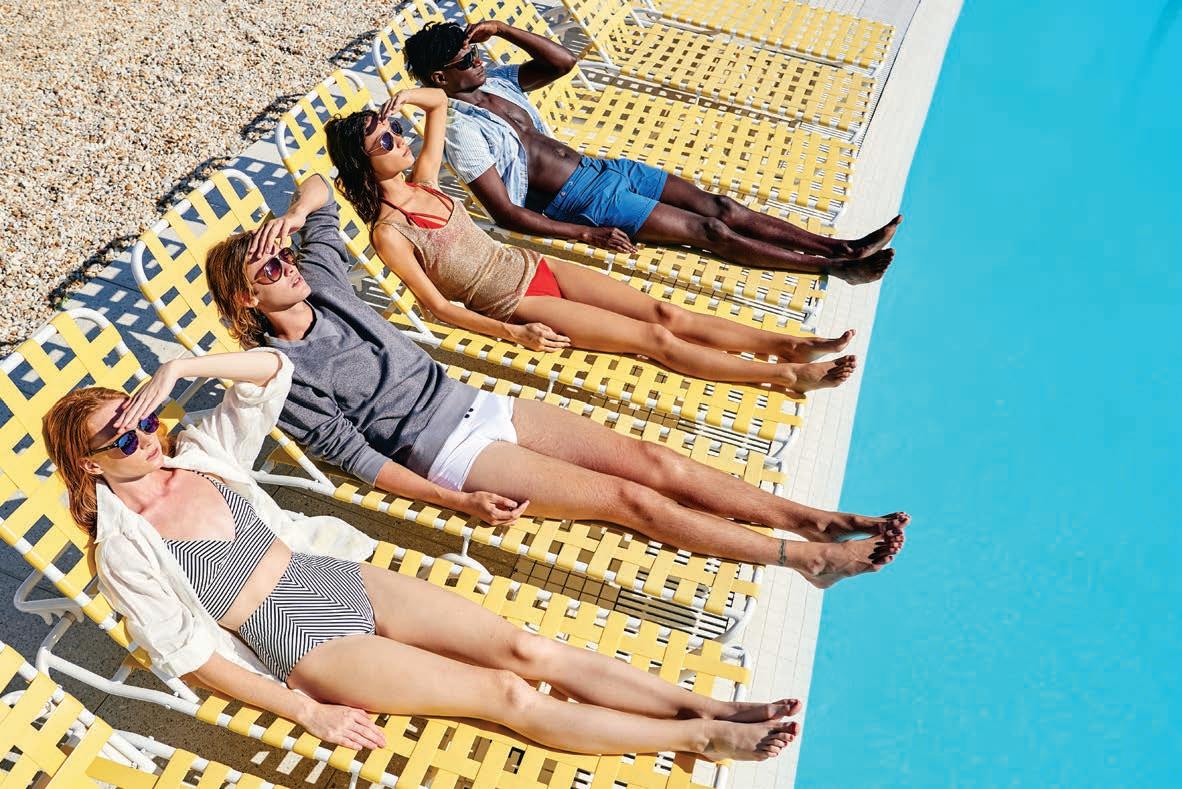
You’ll Need a Place to Stay
Between hotels, rental housing and homes for sale across Miami, luxurious digs abound. Beau monde stalwarts such as the Setai, Faena, and the Four Seasons at the Surf Club are consistently ranked among the country’s top hotels. The perennially solid oceanfront W South Beach recently reopened after a major renovation of its 400 suites and its pool and resort spaces: think barefoot luxury celeb-magnet with a multimillion-dollar art collection, including works by Andy Warhol and Julian Schnabel. Elsewhere, Infinity Hospitality’s new Esmé Miami Beach, South Beach’s most ambitious boutique hotel in years, opens in early 2021, with 145 boho-chic rooms spread over eight historic French and Spanish Mediterranean revival buildings on Española Way, the beachside historic arts village turned tourist trap that’s poised to have another moment in the sun. For those seeking unadulterated pampering just o the beaten path, Acqualina Resort in Sunny Isles keeps winning accolades for its scene- and attitude-free spa and beach programs.
Not all pool scenes are created equal, and three rule Miami: The Standard Spa is the hippest and most magical, featuring an enormous pool on the bay and arguably the best sunset vantage point in town, to say nothing of the young lovelies filling the chaises; the Biltmore Hotel’s 23,000-squarefoot, 600,000-gallon pool in the heart of Coral Gables o ers a terrific dip after a spirited round of golf; and the Delano South Beach pool, still a ridiculous wonderland of palm trees and cabanas two decades after Kate Moss and Johnny Depp et al. made it their preferred watering hole in the mid-’90s. For private luxury home rentals by the week or month, Sobe Villas o ers 60 exceptional houses across the city, many right on the water, perfect for hiding from paparazzi. But to live in the most Insta-worthy residential building of the moment, buyers need look no further than Zaha Hadid’s last residential project, 1000 Museum, with its intoxicating alien exoskeleton, full-floor residences, and private rooftop helicopter pad, or the gleaming black Porsche Design Tower, featuring a decadent freight elevator that transports owners’ cars straight into their units, even 60 stories in the sky.

FASHION PLATES Clockwise from right: Sashimi at Chotto Matte; New York strip at Juvia; a chartered Azimut Yacht from YachtLife.

You’ll Need Sustenance

You’ll Need Water Transportation
If you’re floating, you’re boating, and choosing an oceangoing vessel is de rigueur in Miami. While engaging a charter company like YachtLife will yield a day of house music and bubbly (and the attendant hangover), buying the sea dream embodies a never-ending IRL odyssey. Island Gardens on Watson Island is Miami’s only marina for giga-yachts, those complete with Airbus helicopters whirring back from Bahamian golf excursions, ideal for Jerry Jones’s 357-foot Bravo Eugenia, Lukas Lundin’s magnificent 274foot Savannah, or Farkhad Akhmedov’s 377-foot Luna. Discreetly tucked into an Aventura neighborhood is Magnum Marine, hand-crafters of Lenny Kravitz’s impossibly sexy 60-foot boat of choice. But for a luxurious thrill, book an appointment at the Ferretti Group’s luxurious in-water showroom in Fort Lauderdale, just 30 minutes away, where Pershing Yachts, Riva Yachts, and Wally Yachts are nestled for qualified tours.
It has been said that Miami is where dreams go to diet, but the city is a flaming hotcake of world-class restaurants (Juvia! Alter! Brava!), and mouthwatering tentpole events such as February’s South Beach Wine and Food Festival. South Beach’s Red the Steakhouse, chef Peter Vauthy’s vaunted steak and seafood house, specializing in Miyazaki Japanese Kobe A5, and baseball bat–sized Alaskan king crab legs, recently relocated to a bright, airy space on South Pointe Drive, debuting both brunch and an expansive outdoor terrace with marina views. After dinner, stroll to the ocean via South Pointe Park. On Lincoln Road, restaurant MILA by Gregory and Marine Galy quite literally o ers the rooftop high life, serving Mediterranean and coastal Japanese cuisine in a breathtakingly glamorous indoor/outdoor bohemian chic motif, complete with a stunning water feature and a bar under the stars. On Collins Avenue, relax on Fi’lia South Beach’s outdoor terrace for honest Italian and cold prosecco, or patronize Byblos for delicious meze and mediterranean fare, like duck kibbeh and lamb ribs. Downtown, don’t miss Deme Lomas’s award-winning Niu Kitchen for contemporary Catalan, including his unforgettable cold tomato soup with mustard ice cream. And no trip to

Miami is complete without a meal at the iconic Joe’s Stone Crab on Washington Avenue on South Beach, or at Mandolin Aegean Bistro, the outdoor taverna in the Design District owned by husband and wife team of Ahmet Erkaya and Anastasia Koutsioukis, or Chotto Matte, the Peruvian-Japanese fusion restaurant that brings Tokyo sophistication to the tropics. Miss Brooklyn? Make like Beyoncé and Jay-Z when they’re in town and visit Lucali in buzzy Sunset Harbour for mouth-boggling pizza.
The international jet set (and yacht set) gather here like cashed-up spring breakers. You’ll Need Culture
In the last decade or so, Miami’s Art Week, including the storied Art Basel Miami Beach and Design Miami, has both attracted deep-pocketed collectors and made it a serious port of call on the cultural calendar. Elsewhere, The Underline, Miami’s $120 million homage to NYC’s High Line and the most expansive public works project ever, just opened its first phase, spanning from the Miami River to Coral Way with art and parkland. The Institute of Contemporary Art, in Miami Design District, is the city’s most important new contemporary art museum in a decade, with emerging and under-recognized artists, experimental installations, and an art garden for soaking up sunshine and entertaining lofty thoughts. In Allapattah, the recently relocated Rubell Museum houses one of the world’s most important private modern art collections, with 7,200 works by more than 1,000 artists, including Jean-Michel Basquiat, Keith Haring, Cindy Sherman, and more, and is a must-see. Downtown, adjacent to the always worthwhile Herzog & de Meuron–designed Pérez Art Museum Miami in Museum Park, is the Frost Museum of Science, complete with a rooftop shark-filled aquarium and a stellar planetarium, presented alongside thoughtful science exhibits and interactive workshops. Lastly, simply walk around Wynwood, the warehouse district turned art world stomping ground, for acres of vivid gra ti and genre-bending, large-scale street art. Between stops, galleries, and shops, grab cool-down cocktails and frothy pints in one of the neighborhood’s four local breweries.

PIGMENT OF IMAGINATION Above: Hudson in a Baby Blue Suit (2019) by Amoako Boafo hangs in the Rubell Museum. Right: The Wynwood Building, a local center for the arts.

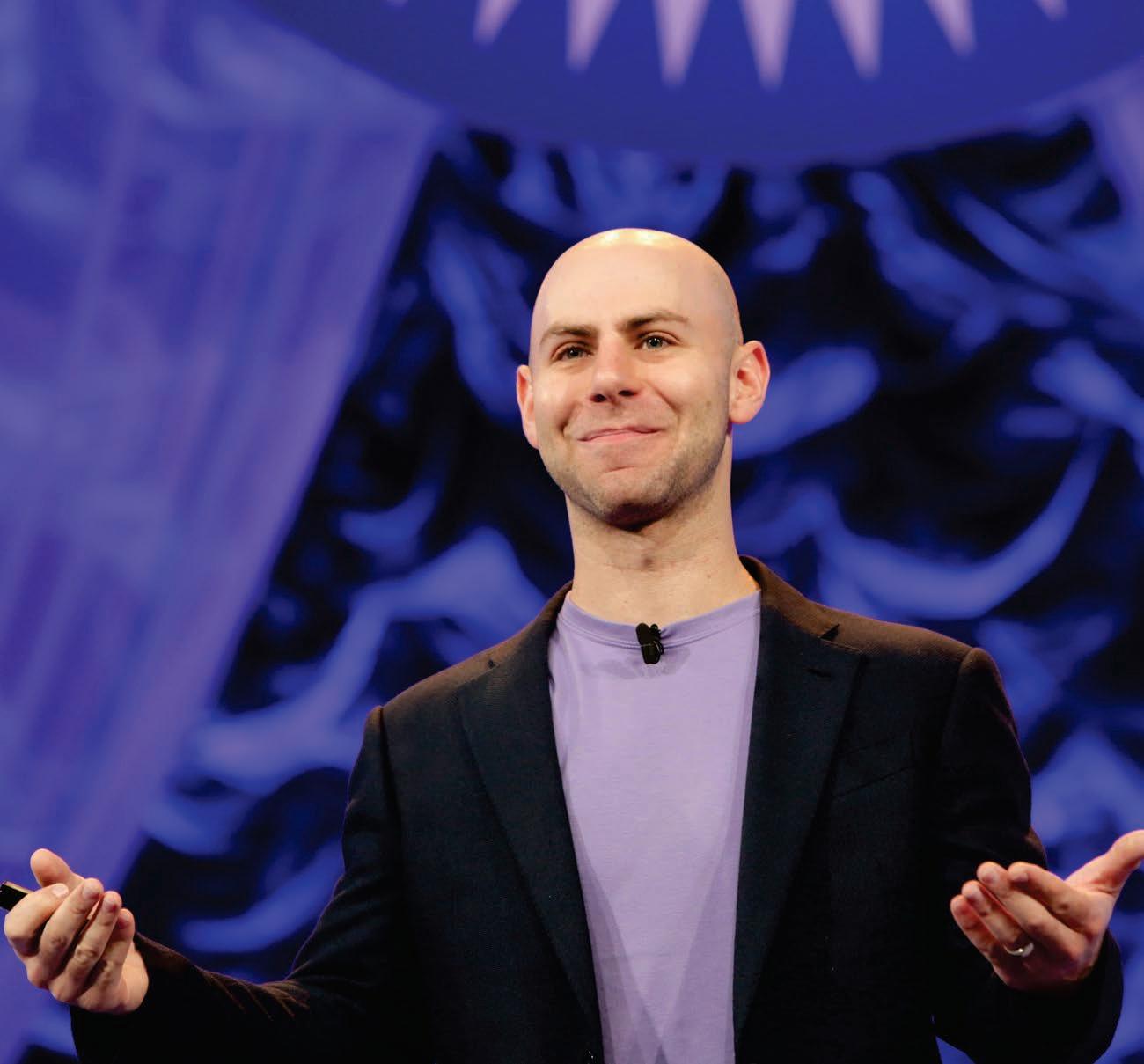
PURPLE CURTAIN MAJESTY Adam Grant addressing the Pennsylvania Conference for Women in 2016.
MARLA AUFMUTH/GETTY IMAGES FOR PENNSYLVANIA CONFERENCE FOR WOMEN
Giver Takes All
With his groundbreaking bestseller Give and Take, the organizational psychologist Adam Grant created a revolutionary way of thinking about personal success. In the following excerpt, he explains why it pays to give
According to conventional wisdom, highly successful people have three things in common: motivation, ability, and opportunity. If we want to succeed, we need a combination of hard work, talent, and luck. But there is a fourth ingredient, one that’s critical but often neglected: success depends heavily on how we approach our interactions with other people. Every time we interact with another person at work, we have a choice to make: do we try to claim as much value as we can, or contribute value without worrying about what we receive in return?
I’ve dedicated more than ten years of my professional life to studying these choices at organizations ranging from Google to the U.S. Air Force, and it turns out that they have staggering consequences for success. Social scientists have discovered that people di er dramatically in their preferences for reciprocity—their desired mix of taking and giving. There are two kinds of people who fall at opposite ends of the reciprocity spectrum at work. I call them takers and givers.
Takers have a distinctive signature: they like to get more than they give. They tilt reciprocity in their own favor, putting their own interests ahead of others’ needs. Takers believe that the world is a competitive, dog-eat-dog place. They feel that to succeed, they need to be better than others. To prove their competence, they self-promote and make sure they get plenty of credit for their efforts.
In the workplace, givers are a relatively rare breed. They tilt reciprocity in the other direction, preferring to give more than they get. Whereas takers tend to be self-focused, givers are other-focused, paying more attention to what other people need from them. These preferences aren’t about money: givers and takers aren’t distinguished by how much they donate to charity or the compensation that they command from their employers. Rather, givers and takers di er in their attitudes and actions toward other people. If you’re a taker, you help others strategically, when the benefits to you outweigh the personal costs. If you’re a giver, you might use a di erent cost-benefit analysis: you help whenever the benefits to others exceed the personal costs.
Professionally, few of us act purely like givers or takers, adopting a third style instead. We become matchers, striving to preserve an equal balance of giving and getting. Matchers operate on the principle of fairness: when they help others, they protect themselves by seeking reciprocity. If you’re a matcher, you believe in tit for tat, and your relationships are governed by even exchanges of favors.
It’s tempting to reserve the giver label for larger-than-life heroes such as Mother Teresa or Mahatma Gandhi, but being a giver doesn’t require extraordinary acts of sacrifice. It just
involves a focus on acting in the interests of others, such as by giving help, providing mentoring, sharing credit, or making connections for others. Outside the workplace, this type of behavior is quite common. According to research led by Yale psychologist Margaret Clark, most people act like givers in close relationships. We help our families and friends without keeping score.
Many of us are intuitively drawn to giving. Over the past three decades, the esteemed psychologist Shalom Schwartz has studied the values and guiding principles that matter to people in di erent cultures around the world. One of his studies surveyed reasonably representative samples of thousands of adults in Australia, Chile, Finland, France, Germany, Israel, Malaysia, the Netherlands, South Africa, Spain, Sweden, and the United States. He translated his survey into a dozen languages, and asked respondents to rate the importance of di erent values. Here are a few examples: List 1: Wealth (money, material possessions); Power (dominance, control over others); Pleasure (enjoying life); Winning (doing better than others). List 2: Helpfulness (working for the well-being of others); Responsibility (being dependable); Social justice (caring for the disadvantaged); Compassion (responding to the needs of others).
Takers favor the values in List 1, whereas givers prioritize the values in List 2. Schwartz wanted to know where most people would endorse giver values. Take a look back at the twelve countries above. Where do the majority of people endorse giver values above taker values?
All of them. In all twelve countries, most people rate giving as their single most important value. They report caring more about giving than about power, achievement, excitement, freedom, tradition, conformity, security, and pleasure. In fact, this was true in more than seventy di erent countries around the world. Giver values are the number-one guiding principle in life to most people in most countries.
On some level, this comes as no surprise. As parents, we read our children books like The Giving Tree and emphasize the importance of sharing and caring. But we tend to compartmentalize giving, reserving a different set of values for the sphere of work. We may love Shel Silverstein for our kids, but the popularity of books like Robert Greene’s The 48 Laws of Power—not to
SIMON SINEK, AUTHOR
mention the fascination of many business gurus with Sun Tzu’s The Art of War—suggests that we don’t see much room for giver values in our professional lives.
The fear of being judged as weak or naïve prevents many people from operating like givers at work. Many people who hold giver values in life choose matching as their primary reciprocity style at work, seeking an even balance of give and take. In one study, people completed a survey about whether their default approach to work relationships was to give, take, or match. Only 8 percent described themselves as givers; the other 92 percent were not willing to contribute more than they received at work.
Professionally, all three reciprocity styles have their own benefits and drawbacks. But there’s one style that proves more costly than the other two. You might predict that givers achieve the worst results—and you’d be right. Research demonstrates that givers sink to the bottom of the success ladder. Across a wide range of important occupations, givers are at a disadvantage: they make others better o but sacrifice their own success in the process.
Across occupations, it appears that givers are just too caring, too trusting, and too willing to sacrifice their own interests for the benefit of others. There’s even evidence that compared with takers, on average, givers earn 14 percent less money, have twice the risk of becoming victims of crimes, and are judged as 22 percent less powerful and dominant.
So if givers are most likely to land at the bottom of the success ladder, who’s at the top— takers or matchers? Neither. When I took another look at the data, I discovered a surprising pattern: It’s the givers again.
Givers dominate the bottom and the top of the success ladder. Across occupations, if you examine the link between reciprocity styles and success, the givers are more likely to become champs—not only chumps.
What’s unique about the success of givers? Let me be clear that givers, takers, and matchers all can—and do—achieve success. But there’s something distinctive that happens when givers succeed: it spreads and cascades. When takers win, there’s usually someone else who loses. Research shows that people tend to envy successful takers

DROPPING KNOWLEDGE The author delivering a TED Talk in Vancouver.
and look for ways to knock them down a notch. In contrast, when givers win, people are rooting for them and supporting them, rather than gunning for them. Givers succeed in a way that creates a ripple e ect, enhancing the success of people around them. The di erence lies in how giver success creates value, instead of just claiming it.
What I fi nd most magnetic about successful givers is that they get to the top without cutting others down, fi nding ways of expanding the pie that benefit themselves and the people around them. Whereas success is zero-sum in a group of takers, in groups of givers, it may be true that the whole is greater than the sum of the parts.
Armed with this knowledge, I’ve seen some people become more strategic matchers, helping others in the hopes of developing the relationships and reputations necessary to advance their own success. Can people succeed through instrumental giving, where the primary intent is getting? I have suggested that in the long term, the answer might be no.
There’s a fi ne line between giving and clever matching, and this line blurs depending on whether we define reciprocity styles by the actions themselves, the motives behind them, or some combination of the two. It’s a deep philosophical question, and it’s easy to identify with a range of views on how strategic matchers should be evaluated. On the one hand, even if the motives are mixed, helping behaviors often add value to others, increasing the total amount of giving in a social system. On the other hand, our behaviors leak traces of our motives. If recipients and witnesses of our giving begin to question whether the motives are self-serving, they’re less likely to respond with gratitude or elevation. When strategic matchers engage in disingenuous e orts to help others primarily for personal gain, they may be hoisted by their own petard: fellow matchers may withhold help, spread negative reputational information, or fi nd other ways to impose a taker tax. To avoid these consequences, would-be matchers may be best served by giving in ways that they find enjoyable, to recipients whose well-being matters to them. That way, even if they don’t reap direct or karmic rewards, matchers will be operating in a giver’s mind-set, leading their motives to appear—and become—more pure. Ultimately, by repeatedly making the choice to act in the interest of others, strategic matchers may find themselves developing giver identities, resulting in a gradual drift in style toward the giving end of the reciprocity spectrum. We spend the majority of our waking hours at work. This means that what we do at work becomes a fundamental part of who we are. If we reserve giver values for our personal lives, what will be missing in our professional lives? By shifting ever so slightly in the giver direction, we might fi nd our waking hours marked by greater success, richer meaning, and more lasting impact. From the book Give and Take by Adam Grant, published by Viking, an imprint of Penguin Publishing Group, a division of Penguin Random House LLC. Copyright © 2013 by Adam Grant. Think Again by Adam Grant will be published in February 2021 by Viking.
WISH U WERE HERE Above: A photo-illustration of Winthrop House at Harvard, where the fall semester is fully remote; opposite: students at Grinnell College in Utah are among those re-creating dormitory life in rented houses for hand-picked groups of friends.


House Party TUnable to attend elite colleges in person, thousands of wealthy students are renting group houses to serve as private dorms while they study remotely. he most important moment of a Harvard student’s undergraduate career happens in March of their first year. Housing Day is when freshmen receive a hand-delivered envelope containing the name of their
Brandon Presser asks, What house—the dormitory they’ll call home for the could possibly go wrong? next three years of college. Traditionally, Harvard’s houses—named for a coterie of Boston Brahmin families—have been an inextricable part of each student’s on-campus identity. They sleep there, eat there, and compete against other houses in a variety of tournaments. Think: Hogwarts students being sorted into Slytherin or Gry ndor, except by an opaque lottery system instead of a magical hat.
At the beginning of the Fall 2020 semester, however, most students didn’t move into any of the 12 upperclassmen dorms as usual. Instead, new and unfamiliar houses were added to the storied nomenclature: Beach House, Mountain House, and even Farm House.
When the country’s elite universities restricted the return of students at the beginning of the scholastic year due to Covid, thousands of wealthy teenagers sought to re-create campus life on their own terms (paid for by their parents), renting houses on the beach, in ski towns, and around big cities. Just because their classes were going virtual didn’t mean they had to give up their keggers.
“After much Airbnb searching and a great many spreadsheets, we decided to live in an off-season resort outside Durango, Colorado,” says Erik Boesen, a rising sophomore at Yale. Hiking, fishing, and après-ski gatherings have now become just as commonplace as their homework. “While it’s impossible to fully re-create a college experience, this living situation has allowed us to grow in ways that we couldn’t have at Yale,” Boesen notes. “So far it’s come out great.”
For many, however, relegating classes to Zoom has put the value of a quarter-million-dollar bachelor’s degree into question. “Right now I’m paying full-blown tuition for two children,” says Cheryl Smith, a senior vice president at Merrill Lynch. When news of campus closures were confirmed over the summer, neither of her children—a rising
COULDN’T HAVE AT YALE.”
ERIK BOESEN, RISING SOPHOMORE
freshman and rising senior—wanted to take time o . “My daughter is living with five girls; they’re online learning together, trying to create their college vibe,” Smith says; she’s found an apartment for her son in Manhattan, who had expected to start university at Parsons this fall. “I want him to get the New York feel: they’ve been having small group parties on rooftops—it’s great exposure.”
Smith, like many of her friends with kids in university, is less concerned about the potential for o -campus housing to devolve into unsupervised fraternities, and more focused on the networking opportunities that on-campus learning inherently a ords. “They did the Covid quarantining—stuck at home—it’s time for them to be with their peers,” Smith adds. “This is really about social skills and socialization; I’m paying [more than $100,000] so my children can have an experience.”
While students and parents are grappling with re-creating college communities away from campus, the Silicon Valley buzzards have begun to swoop in on the educational components of distance learning. Just as major tech brands like Amazon and Apple have reshaped the entertainment industry over the past decade, digital platforms could profoundly disrupt academia as well. Both companies have trillions of dollars at their disposal—exponentially more than Harvard’s $40.9 billion endowment (the largest of any higher learning institution)—to recruit the best minds across every discipline, like they did with Hollywood’s top producers, directors, and actors.
Before you write off the notion of, say, an Amazon University as dystopian fantasy, there is a precedent. Several colleges with cachet, like Carnegie Mellon and Vanderbilt, were built by the biggest brands that defined America’s Industrial Revolution only a hundred-plus years ago. (Fun fact: If steel baron Andrew Carnegie’s fortune were adjusted for inflation, he’d be worth twice as much as Je Bezos today.)
Although there are currently a handful of standout virtual education platforms, “the o ering still isn’t as good as online learning should be, which tarnishes its brand,” notes Michael Horn, the cofounder of the Clayton Christensen Institute for Disruptive Innovation and author of Choosing College. Horn is keen for our new reliance on digital classrooms to remain: “The longer this persists, the more the experience should open people’s minds to alternative ways of creating tremendous learning opportunities.” Horn has watched as elite institutions bolster their o erings, “but students are now looking for alternative ways of learning that are less costly; it’s possible to have a selective institution that is a ordable and creates an incredible [online] experience.”
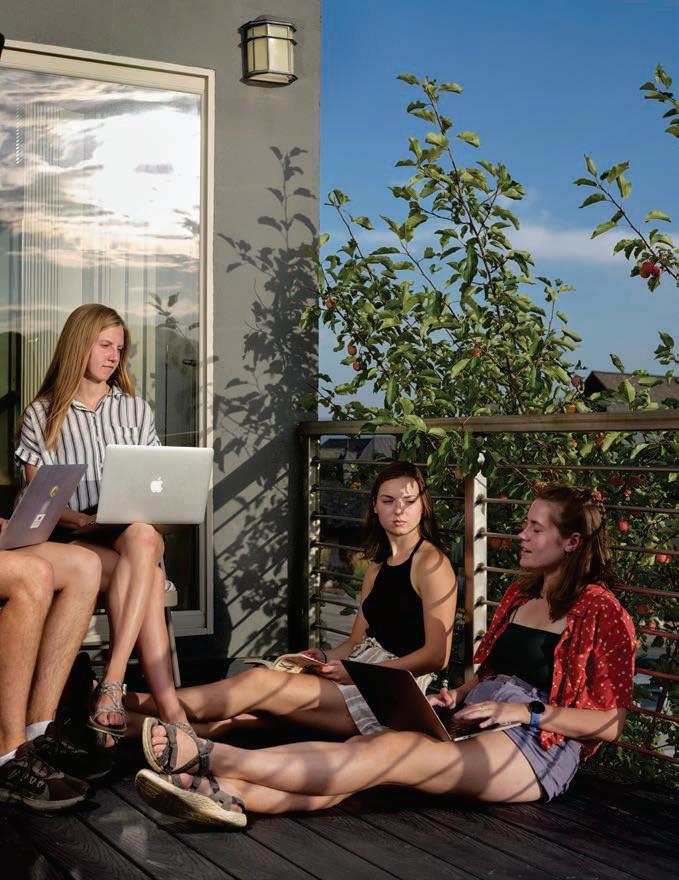
There’s a reason many institutions glamorize their study-abroad programs: it opens up space in the dorms for more students—and their fees. Now, without brick-and-mortar constraints, an Ivy League school could easily take twice the number of incoming frosh—doubling both its revenue and the connections its student body will have with the next generation of elite.
Even if none of them have ever met in person.

Going naked was like waving a defiant flag in the ’60s counterculture, as at muddy Woodstock. Al Goldstein founded Screw magazine in 1968, and Suck, the radical feminist mag, was launched in London the following year. Larry Levenson, founder of the notorious 1970s sex club Plato’s Retreat, is remembered by Anthony Haden-Guest, an occasional visitor to his establishment Strictly Platonic Germaine Greer, a Suck stalwart, was involved in a landmark event I attended in Amsterdam in 1971—the second iteration of the Wet Dream Festival, a showing of international porno movies. The following year Deep Throat and Behind the Green Door opened, making Linda Lovelace and Marilyn Chambers, their key players, cross-culturally known names. In 1974, Goldstein launched the cable talk show Midnight Blue, and “porno chic”— a phrase coined that year by Ralph Blumenthal of the New York Times—was surging.
Larry Levenson was more than ready to ride this wave.
A friend of Goldstein’s from high school in Brooklyn, he had been working mundane jobs such as selling sodas in Coney Island and managing a McDonald’s. But after being plunged into the swingers’ milieu by a woman he met in a bar, he quickly decided he had found a calling that suited both his talents and his inclinations: swing parties.
His skills developed to such an extent that in 1977 he opened a space for swingers to mingle (and get down to it) in the basement of a small hotel on East 23rd Street between Lexington and Third Avenues. This was the first Plato’s Retreat.
Soon, Levenson was attracting such a following that the same year he moved his business into a more ample basement uptown, in the Ansonia Hotel, a handsome building on Broadway between West 73rd and 74th. Until 1974, it had been home to the Continental Baths, a gay club where Bette Midler launched her career and a place where even Chubby Checker performed. As New York’s sex-oriented spaces were traditionally for gay men, Levenson was aware that o ering a venue for public straight sex was breaking new ground.
He was outspoken on this subject, saying he was bringing to the straight world the liberty of the gay clubs. His sincerely held rationale was that no man was monogamous, and that swinging would replace cheating. Plato’s, Levenson said, was a “couples club.”
Such a couple arriving at Plato’s was made aware of the rules at the door. “NO THREESOMES AT ANYTIME” was one. Also “NO ONE ADMITTED FULLY DRESSED” and “WHEN THE FEMALE LEAVES THE MATS, HER MATE WILL BE ASKED TO LEAVE.” More on “the Mats” shortly.
A couple paid $25. The deliberately unimpressive front door opened onto a steep flight of steps, which led down to the action, which was impressive.
DJ Bacho controlled the music, and there was sometimes dancing, most of the dancers being wholly or partially naked. The crowd was largely couples; solitary women were okay but single men were a no-no. So too was man-on-man action, though random displays of female bisexuality were very much okay.
Beginners would often wear towels, but these would usually be shed as they wandered the available venues, such as the Mats: the Mattress Room, which was furnished with mattresses that could be covered with a couple hundred interlocked bodies on a busy night. But there was also the bathhouse, the locker room, and private cubicles for the shy, as well as Ping-Pong and pool tables, which might also be unusably covered with heaving flesh. And, believe me, the rule that threesomes were not allowed was not too strictly enforced. There was also a swimming pool, and this saw action too, natch. In American Swing, an excellent 2008 documentary about Plato’s, codirected by Mathew Kaufman and Jon Hart, a young woman is chatted up by Levenson who suggests that she take
ALWAYS TAKE SOMETHING OFF Opposite: Larry Levenson ready for action at Plato’s Retreat in 1980. Above: Letting it all hang out at Screw magazine’s tenth anniversary party.
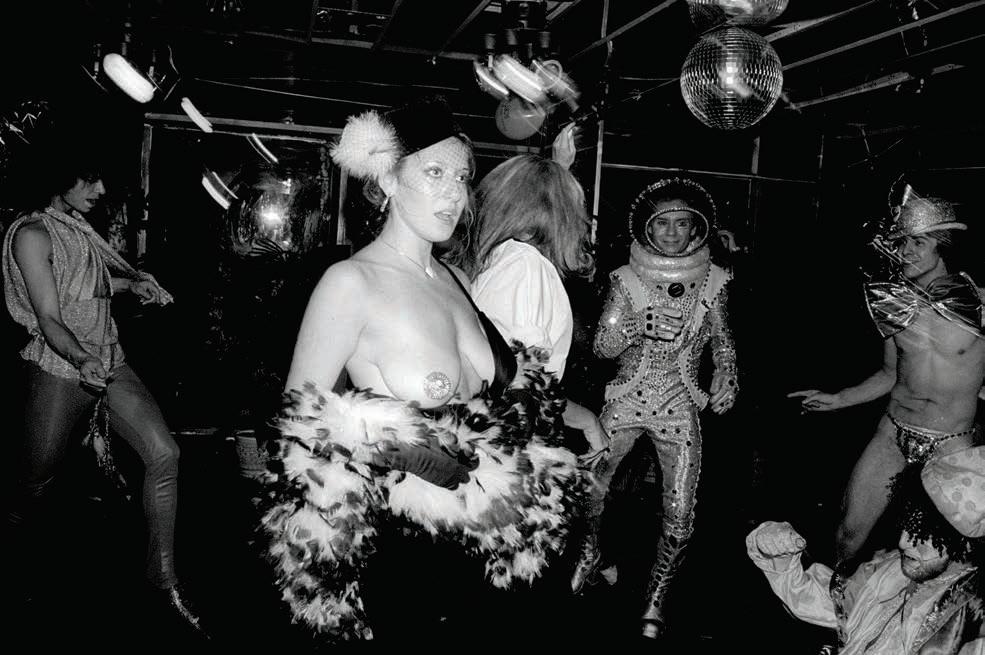
a dip. She says she needs to go to the ladies’ room.
“Oh, come on in, “ Levenson coaxed. “The water’s nice and warm. And that’s how it got that way.”
This was Mary, who would soon be sharing his life, and the drollery was not untypical of Larry, who struck me as open, friendly, and somewhat ingenuous. I was going to Plato’s now and again because I had arrived in New York just a few years before, and visiting Brit friends would often call upon me to take them to this worldwide notorious hot spot. That is why I was included in the aforementioned documentary, wherein I observe that I linked Plato’s to Studio 54 as elements that had made New York “the world’s most exciting city.”
Yes, Studio 54 had also opened in 1977, discomania seized New York, and Plato’s benefited from that avid curiosity and hunger for nocturnal highs. It became huge, Levenson was anointed “The King of Swing,” and just as certain individuals became Studio-famous, like Disco Sally and Rollerena, the Wall Streeter wearing a skirt and blades, so there were famous Plato’s regulars, like Jamie Gillis, Captain John, and some with wink-wink porn names, like Annie Sprinkle and Danny, the Wonder Pony. As with Studio, Plato’s was kept in the headlines by gossip about famous faces spotted there, whether Sammy Davis Jr., Frank Sinatra, or cast members from Saturday Night Live.
This was a specific moment in the development of the celebrity culture, its virginity you might say, a time when you could spot Michael Jackson in the foyer of Studio or a sports star in Plato’s, but nobody would be likely to approach them. The significant di erence was that the famous face entering a happening disco would be likely to disappear into the VIP room—but Plato’s had no VIP room. Photo reportage might give the impression that the place pulsed with high octane glam and getting into it was like penetrating the Playboy mansion. Not so, and some who had been drawn by the media heat were chilled.
“I went there because everybody in New York was going to the place,” says Roger de Cabrol, a French friend who arrived in New York more or less when I did. He and his female partner had scooted around, but the scrumptious flesh he had been anticipating was not on display. “It was incredibly sleazy,” he says. “Ugly bodies. Everybody could have been your mother [or] your father.” He did not repeat the experience.
“It was dark and scummy and scroungy,” says Matuschka, the artist and former model most widely known for making the cover of the New York Times magazine in 1993 after a mastectomy.
“They let me walk around naked in my fur coat because it was too expensive to leave in the locker room. I remember people would select you. They would just point. The husband or the wife would want you. But I was just a voyeur.”
In 1980, Levenson moved Plato’s again, this time to West 34th Street. The King of Swing was high on the place, believing that Plato’s was on its way to becoming a franchise. “Within three months there will be four more around the country,” he said on television.
DO YOU COME HERE OFTEN? Swingers get in the mood.
In keeping with the spirit of the place, Mary, his mate, had an affair with their chauffeur. So when Levenson was robbed and badly beaten, some gossips implicated the driver. Others close to Levenson said dealings with wise guys must have gone askew. He showed up soon after at the club, in a wheelchair, but still cock-a-hoop. A reporter quoted him saying, “We don’t pay taxes.”
This was an echo of what Steve Rubell said about Studio. The IRS swooped and got the books,
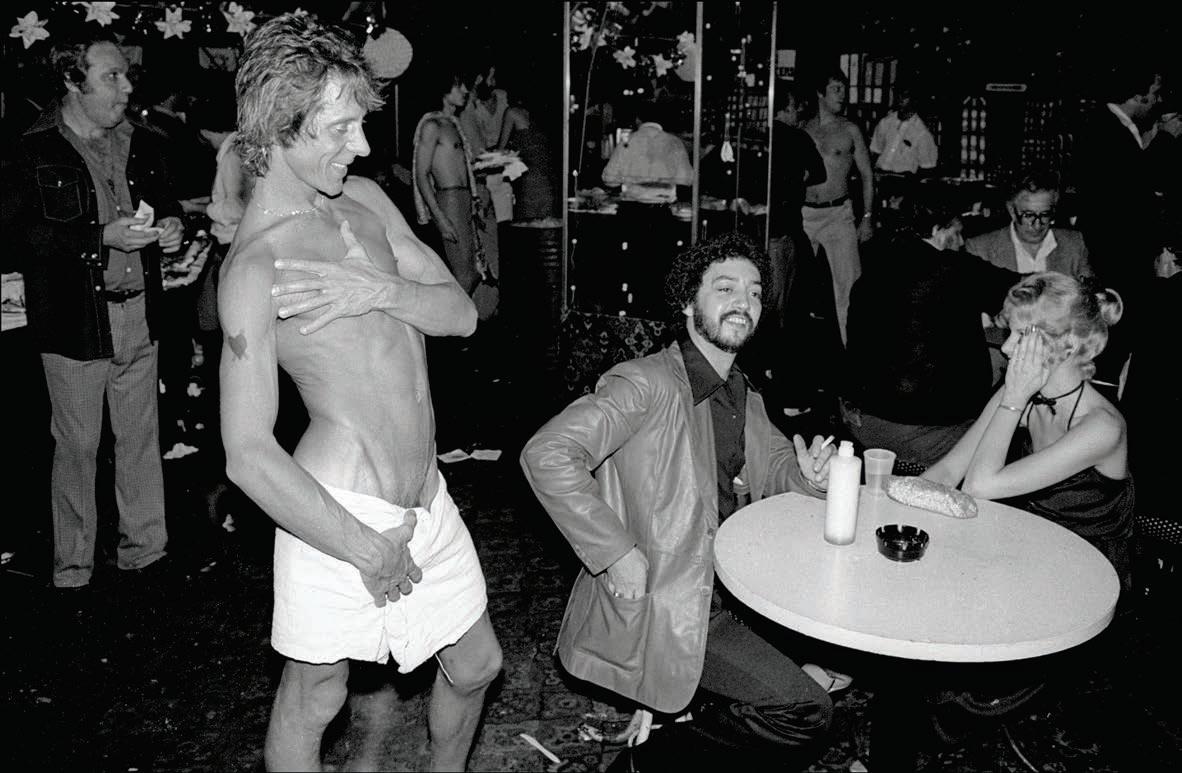
which contained records of three years of meticulous misstatements. He was now confronted by Peter Sudler, the assistant district attorney who had brought down Rubell and his partner, Ian Schrager. Levenson’s defense, which was that he had thought Plato’s was a nonprofit, amused the jury. He was sentenced to eight years and went to jail in 1981. He had a cheerful jailhouse interview with Al Goldstein, got out after 40 months, and had a terrific Welcome Back party at Plato’s.
The time span of hot New York clubs is frequently short, however, and Plato’s was in precipitous decline. AIDS, Covid-19’s dark precursor, had struck. Sex had become self-destructive, and Mayor Ed Koch was closing the gay clubs. But it was learned not only gays were vulnerable. Compounding this new risk, half the women at Plato’s were said to be on the game—four arrested for “working” there in November 1985. That New Year’s Eve, Koch, not wishing to discriminate against gay clubs, had Plato’s Retreat closed down. It would never reopen.
Larry Levenson, who had always survived on a shoestring, was now penniless and started driving a cab. Former clients who spotted him at the wheel reported that he was still smiling, still cheerful, but that the King of Swing had somewhat wised up.
“I thought we had a great family,” he told one. “But I guess I was mistaken. it was just me.” In 1999 he was at Screw’s 30th-anniversary party. Within a year, he died of heart problems at 62. So porno chic was truly dead…or is it? I hear on pretty good authority that, Covid or no, millennials are currently flocking to swing parties.

CHECKERED PAST Clockwise from left: A classic New York City cab outside the Ansonia Hotel; rules of the road; four friends relax before getting frisky; revelers on the smoky dance floor.



PRACTICE, PRACTICE, PRACTICE Carnegie Hall celebrated its 130th season with a virtual opening night featuring recorded performances by artists including Jon Batiste and Angélique Kidjo.

James Taylor
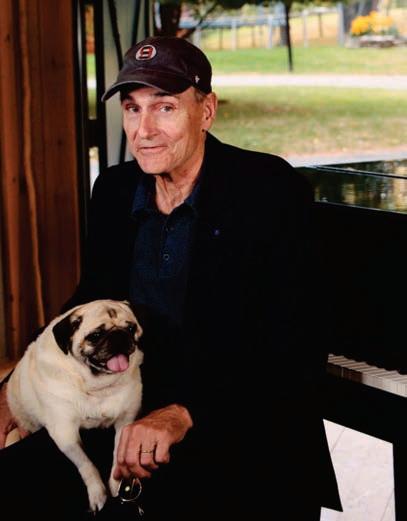

Wynton Marsalis

Coco Rocha on the runway at ChristianSiriano
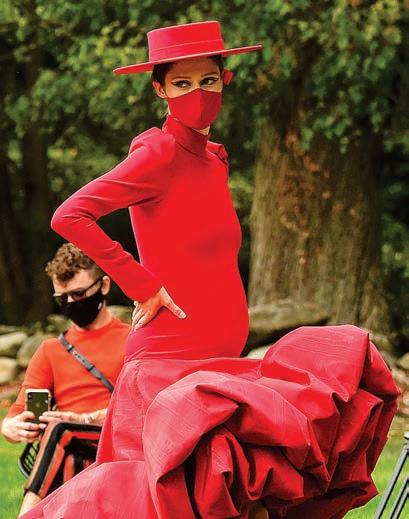
Christian Siriano A scene from Alice + Olivia’s street performance


FROCK STARS A pared-down New York Fashion Week featured live shows by designers including Jason Wu, Stacey Bendet for Alice + Olivia, and Christian Siriano, who invited guests to his Connecticut backyard.
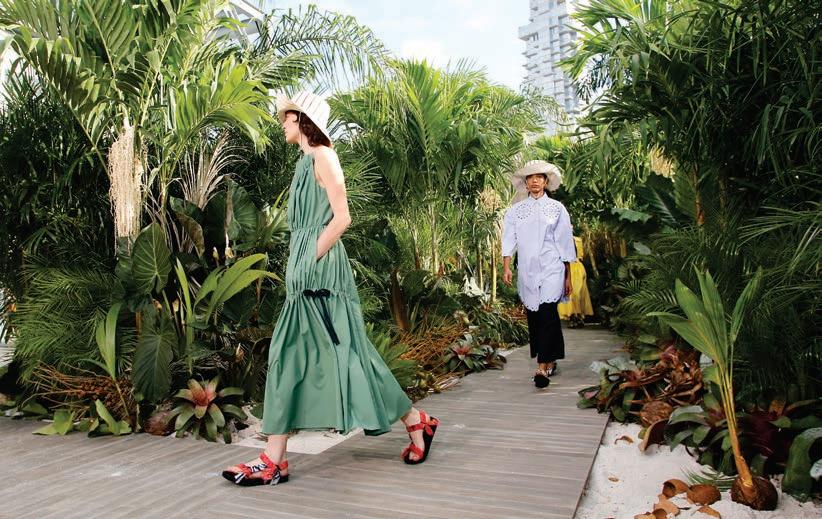

Gillian Miniter
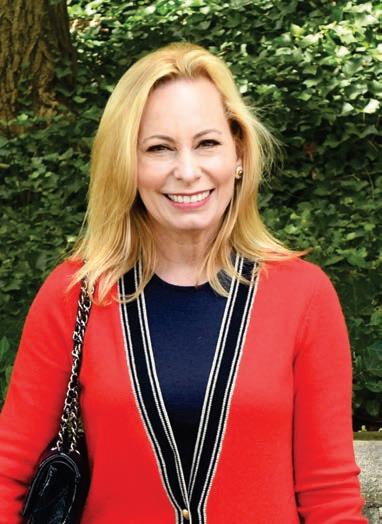
Melanie Fowler and Lara Meiland-Shaw


Ainsley Earhardt, Kathryn Beal, and Laurie Constantino
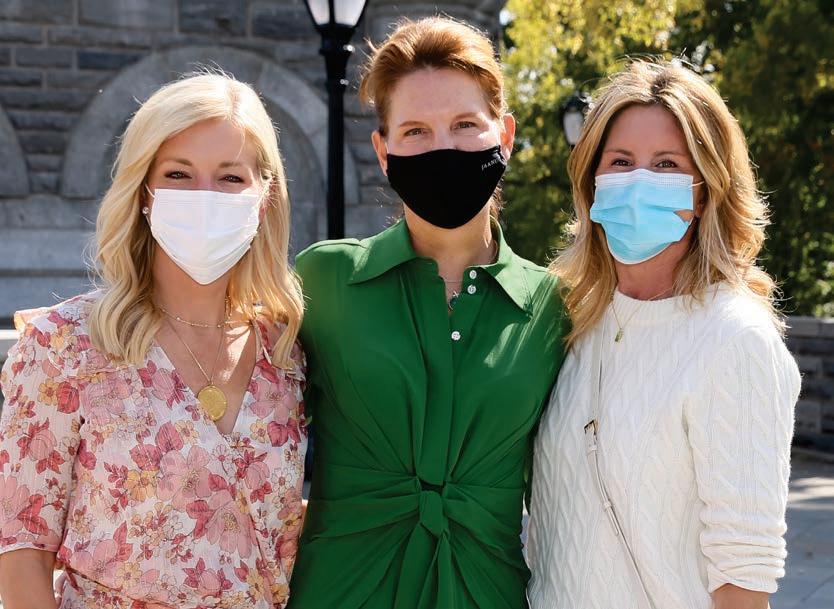
GREEN DAY The Women’s Committee of the Central Park Conservancy raised more than $300,000 with its Picnic for the Park, cochaired by Melanie Charlton Fowler, Shannon Davis Henderson, Kristy Korngold, Karen Thornwell May, and Jenna Segal, and supported by Nordstrom.

The Fresh Prince of Hot Air
Posey Wilt imagines a week in Prince Harry’s Hollywood diary

Monday
I must say, this Netflix bag is a jolly good wheeze. The Duchess is so much more relaxed now that we have cameras everywhere. And the best thing is, she says as producers, we’ll get to keep the Oscar!
Tuesday
Met Archie’s new agent today—she says People magazine wants to put him on their “Two Under Two” power list of Hollywood babies. Smashing!
We also saw prototypes for our new product lines, including bobbleheads of the Royal Family. The Duchess joked that their heads should be detachable, “just in case history happens.” I do adore my darling’s American sense of humour!
Wednesday
Some more good news—the Duchess tells me she wants to get the boat out. At last, an excuse to bring the Royal Yacht Britannia out of mothballs! Grannie will be so pleased, one can’t wait to tell her on the weekly family Zoom.
Bit of rummy with the “Two Under Two” list. Apparently, the other child is something called a Duggar, and that’s a problem? Archie’s agent says not to worry, she’ll see if Madonna has a spare baby—or if not, the Scientologists are bound to have one.
Thursday
Honestly, one doesn’t know why one bothers with these Zoom calls if the family is just going to be rude.
One can always tell when Grannie has been into the sherry. She starts making jokes about naming me after Henry VIII and asking when she can expect “the first” divorce.
Then Kate accused the Duchess of making her bobblehead fat on purpose, and as soon as Grandpapa started bringing up Rudyard Kipling, one knew it was time to ring o .
Friday
Oh, good show! “Two Under Two” is happening again, thanks to our marvelous new friend, Angelina Jolie. A frightfully good sport, she has agreed to adopt a baby during her ayahuasca retreat in Suriname to make sure Archie stays in the “right” company.
Saturday
Unbelievable. Angelina adopted twins—pushing Archie o the list entirely. One is beginning to suspect that friendships in this town might not be what they appear. Silver lining: Archie’s agent has an audition lined up. Apparently, it’s an action-oriented Saved By the Bell prequel called Day Care: Bayside, and he’s up for the Mario Lopez role. One could not be prouder!
Sunday
Another blow. Now the Duchess is telling me she didn’t say she wanted to “get out the boat,” she said, “Get out the vote.”
Complete miscommunication, she said. Just like the time she accidentally sent her headshot to Britain’s Royal Mint, with a note saying, “In case you want to put someone cuter on the coins, xoxo.”
It does pain one that the Duchess continues to be so misunderstood. But no doubt once the public gets to see the real us on Netflix, all will be resolved.

Gary R. DePersia
Licensed Associate Real Estate Broker m 516.380.0538 | gdp@corcoran.com
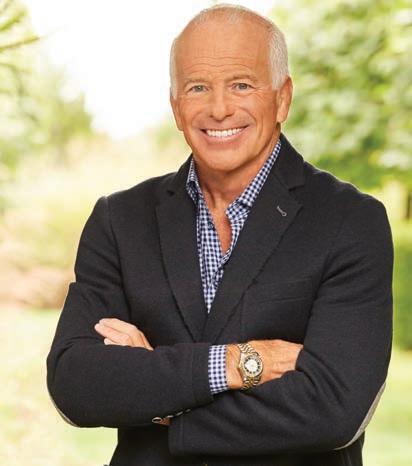
Beach Lane Oceanfront





Wainscott. Reigning over .55 acres, an impressive sea side edifice sprawls along 30 feet of beachfront on iconic Beach Lane. A awless symphony of architecture, construction, landscape design and interior composition has resulted in a stunning opus that finds harmony within 11,000 SF on 4 separate tiers of living space. asterfully built by ayfair Construction, the stucco, teak and granite residence has been exquisitely furnished by ulia Roth esigns. Barnes Coy Architects created a highly unique residence that in the words of Chris Coy is comprised of three separate pavilions.... offering opaque surfaces of teak, stucco, granite and inc that alternate with transparent swaths of tempered glass. The central pavilion is anchored on one end by the Bulthaup kithen from where you look out to the dramatic great room beneath a ft ceilings and framed by walls of glass and warmed by a fireplace anchoring the other end of the great room. The eastern pavilion incorporates the den media room and the master wing offering ocean view sleeping chamber, his and her bathrooms and a pair of walk in closets. The western pavilion is a two tiered compilation of five bedroom suites, a recreational room, pool bath and a four car garage. A separate staircase descends to an expansive gym augmented by spa bath with steam and sauna, a large room housing the golf simulator or possible screening room, two staff suites and ends back at the striking entry atrium with elevator.. Outside the expansive deck offers a covered area housing the outdoor kitchen, dining and seaside living room while uncovered areas find ample room for lounging around the 7 infinity edge pool with spa. Landscaping by the LaGuardia esign Group ties the whole estate together. Amenities include a Crestron, Lutron, Sonos and a whole house generator. A private walkway leads over the dune to find 30 of pristine, sandy white beach. The saying if you re lucky enough to live by the sea, you re lucky enough takes on a whole new meaning if you re actually lucky enough to make this incredible oceanfront estate your new home. Exclusive. $52M WEB# 870070
Real estate agents affiliated with The Corcoran Group are independent contractors and are not employees of The Corcoran Group. Equal Housing Opportunity. The Corcoran Group is a licensed real estate broker located at 660 adison Ave, , 10065. All listing phone numbers indicate listing agent direct line unless otherwise noted. All information furnished regarding property for sale or rent or regarding financing is from sources deemed reliable, but Corcoran makes no warranty or representation as to the accuracy thereof. All property information is presented subject to errors, omissions, price changes, changed property conditions, and withdrawal of the property from the market, without notice. All dimensions provided are approximate. To obtain exact dimensions, Corcoran advises you to hire a qualified architect or engineer.




